Learn
Videos
In this lesson you will be viewing six one-minute long video clips from Columbia University's Asian Topics series. As you listen to the speakers you will collect information on a Noh Listening Guide about Noh history, structure, aesthetics, masks, stories, and Noh theatre today. This guide will serve as a useful tool as you read the play at the end of the lesson. Then, you will read through a few online articles and a slide presentation that defines and lists the unique conventions of the traditional Noh form. So let's get started!
Directions:
- Open the 5.08 Noh task, and answer the questions as you listen to the clips. Your completed guide will be submitted at the end of the lesson for Task 1.
- Watch each video. Pause or replay the video if needed to make sure you answer each question correctly.
Videos:
- A Brief History and Introduction (0:38)
- Formal Structure (1:49)
- The Aesthetic of Noh: Simplicity (0:54)
- Use of Masks and Similarity to Greek Theater (1:43)
- Example of a Noh Play: The Story of Atsumori (1:33)
- Noh Theater Today (0:53)
History of Noh
In fourteenth century Japan, playwrights such as Zeami Motokiyo (Zeami or Kanze Motokiyo; c. 1363 - c. 1443) wrote plays to please the nobility. Zeami looked to classic Japanese literature for the subject matter of the Noh plays. His plays dramatized the life of revered gods, brave warriors-like Atsumori, honorable women, mad women, and demons. These became the conventional types of Noh plays. A traditional Noh performance included all five types of plays with comic interludes of Kyogen plays. A Noh performance could take as long as an entire day.
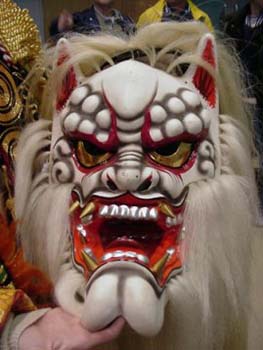
This mask, worn by demonic villan characters in modern Kagura plays, is based on off traditional noh mask designs. Image by Davmandy is licensed under CC BY 3.0.
Noh and Kyogen
Where Noh deal with serious themes from Buddhism such as the great sadness of life, death of loved ones, and lost hopes, Kyogen is irreverent and slapstick. The language of the Noh is poetic and exalted, while that of Kyogen is everyday or earthy; the costumes of Noh are elaborate, while those of Kyogen are plain garments of everyday life worn in fifteenth century Japan. Often the Kyogen story is about a humble person making a fool out of someone in authority or servants trying to outwit their masters. The situations in Kyogen plays are often seen in the stories that are familiar to us, from our own lives, or television sitcoms.
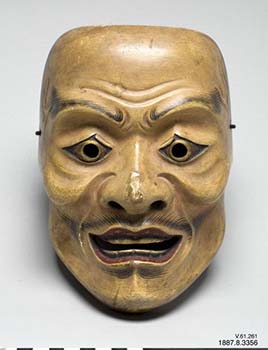
Image by the Museum of World Culture is licensed under CC BY 2.5.
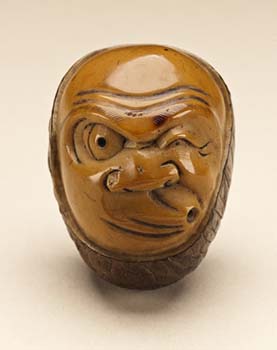
Kyogen mask of Hyottoko from the mid-19th century. Image is in the public domain.
Religion Influence
As you have already seen in the previous lessons, a society's culture is usually reflected in its' characteristic features of everyday existence such as music, art, religious beliefs, customs, etc. So is the case in Noh theatre and especially in the influence of Shinto and Buddhism the two major religions in Japan. Select one or more of the web sites below to read through and become familiar with these two religions. As you read the play Atsumori, you will see how the play reveals religious elements of Japanese culture.
Compare these images of the Shinto shrines to the Noh stage. What similarities to you see?
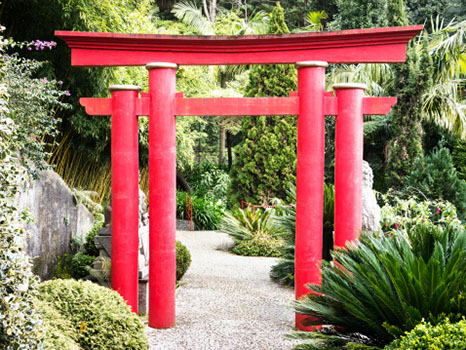
Shinto shrines © Thinkstock.
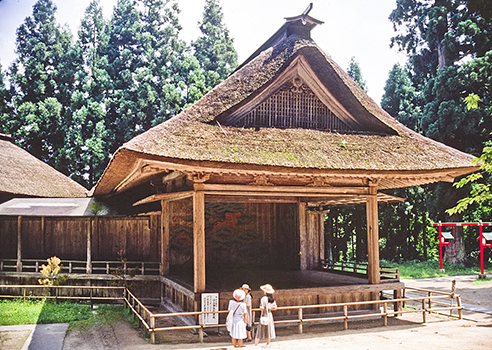
The Nōgakuden (Noh Stage) of the Hakusan Shrine in Hiraizumi, Iwate, Japan. Image is in the public domain.
Noh Conventions
This presentation will serve as both a reference source as you read the play Atsumori and as a study guide for the Theater History quiz at the end of this unit.
Review the Noh Conventions presentation below.
Open Noh Conventions in a new window | Noh Conventions text version
Note: The presentation may take a moment to load.
Additional Resources
Select one or more of these websites to read through to expand your knowledge about Noh theatre. As you read through these sites, think about how Noh compares with other theatre traditions you have studied in this unit.

